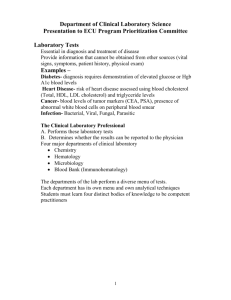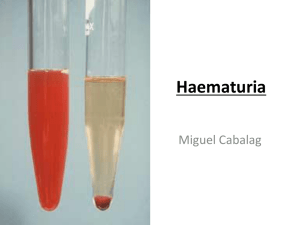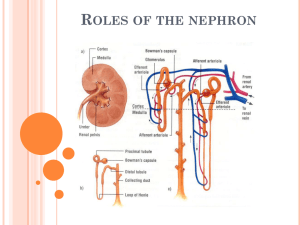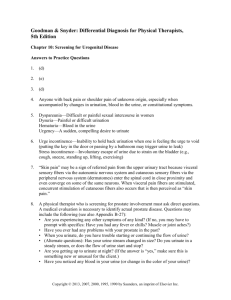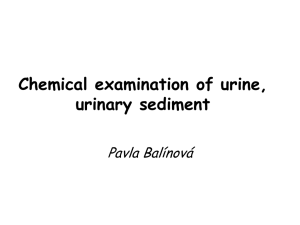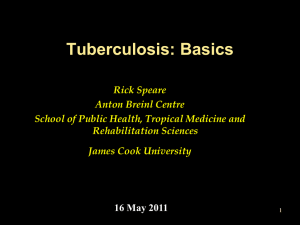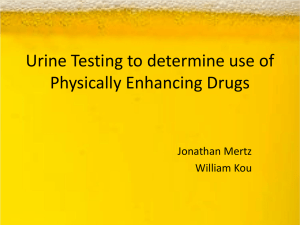OPTICAL PROPERTIES OF URINE, BLOOD PLASMA AND
advertisement
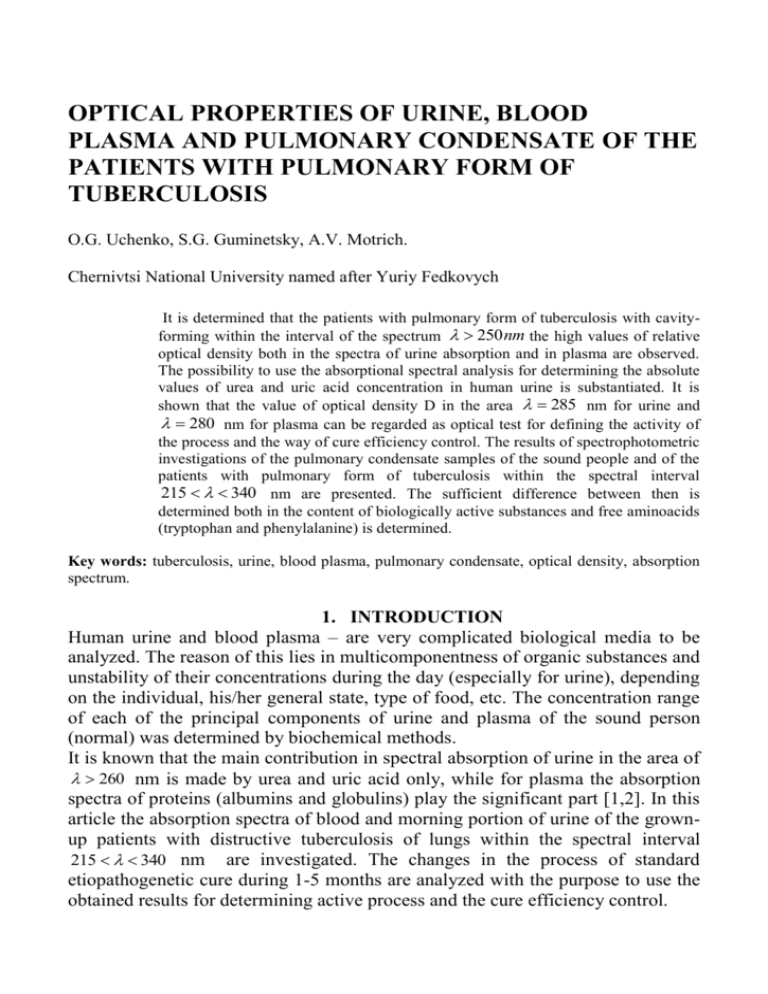
OPTICAL PROPERTIES OF URINE, BLOOD PLASMA AND PULMONARY CONDENSATE OF THE PATIENTS WITH PULMONARY FORM OF TUBERCULOSIS O.G. Uchenko, S.G. Guminetsky, A.V. Motrich. Chernivtsi National University named after Yuriy Fedkovych It is determined that the patients with pulmonary form of tuberculosis with cavityforming within the interval of the spectrum 250 nm the high values of relative optical density both in the spectra of urine absorption and in plasma are observed. The possibility to use the absorptional spectral analysis for determining the absolute values of urea and uric acid concentration in human urine is substantiated. It is shown that the value of optical density D in the area 285 nm for urine and 280 nm for plasma can be regarded as optical test for defining the activity of the process and the way of cure efficiency control. The results of spectrophotometric investigations of the pulmonary condensate samples of the sound people and of the patients with pulmonary form of tuberculosis within the spectral interval 215 340 nm are presented. The sufficient difference between then is determined both in the content of biologically active substances and free aminoacids (tryptophan and phenylalanine) is determined. Key words: tuberculosis, urine, blood plasma, pulmonary condensate, optical density, absorption spectrum. 1. INTRODUCTION Human urine and blood plasma – are very complicated biological media to be analyzed. The reason of this lies in multicomponentness of organic substances and unstability of their concentrations during the day (especially for urine), depending on the individual, his/her general state, type of food, etc. The concentration range of each of the principal components of urine and plasma of the sound person (normal) was determined by biochemical methods. It is known that the main contribution in spectral absorption of urine in the area of 260 nm is made by urea and uric acid only, while for plasma the absorption spectra of proteins (albumins and globulins) play the significant part [1,2]. In this article the absorption spectra of blood and morning portion of urine of the grownup patients with distructive tuberculosis of lungs within the spectral interval 215 340 nm are investigated. The changes in the process of standard etiopathogenetic cure during 1-5 months are analyzed with the purpose to use the obtained results for determining active process and the cure efficiency control. In practical medical investigations there appear more and more research works on using the humor of the air that is breathed out by the human lungs (pulmonary condensate) for diagnostics of the diseases of bronchial system , pre-asthma, ischemic heart disease and other non-specific chronic diseases [3,5]. However, there are no data on the analysis (using the optical techniques, in particular) of pulmonary condensate of the patients with pulmonary form of tuberculosis in the literature. The results of analysis of absorption spectra of the pulmonary condensate of the sound people (as test ones) and the patients with tuberculosis on the same spectral interval 215 340 nm are given below. The possibilities of using these spectra for determining the content of biologically active substances (BAS) as well as the content of the aromatic aminoacids are also considered. 2. THE OBJECTS AND THE TECHNIQUE OF INVESTIGATION The objects of our investigation are urine, plasma and pulmonary condensate of the patients with the destructive tuberculosis of lungs. The routine laboratory analyses of the majority of the patients without the concurrent kidney pathology show that the quantity of proteins in urine is insufficient and it has practically no influence on its optical properties. This makes the urine analysis much more easy both from optical and biochemical point of view. The samples of pulmonary condensate for the investigation were prepared according to the typical technique: 4-5 ml of condensate of the sound people and 2-3 ml of the tuberculous patient had been gathered for 15 minutes in the device for obtaining condensate. The measuring of the absorption spectra of the morning samples of urine, plasma and pulmonary condensate were performed on the spectrophotometer СФ-4А with photometric sphere according to the technique [1,6] which enables to consider the light scattering, as the media under study are colloidal solutions. Urine and plasma were diluted with distilled water in the proportion 1:100. The solutions under study were places in quartz pan with the thickness l = 1 cm. The coefficient of light transmission was measured, and the optical density was calculated by the formula D lg . The experiments prove that the chosen dilution of urine and plasma are optimal for providing the accuracy of measurements at 340 nm [2]. According to [1,2] the main contribution to the value of D for urine in shortwave maximum is made by urea (the rest of components amount to ~1.5% of the total density value). That’s why the spread in measured values for D for different patients at 235 nm is explained by that very fact that their concentration of urea is different. To estimate the real contribution of uric acid in the total optical density of urine in the area 250 nm, it is convenient to standardize the spectra for every case by the values of optical density in maximum, which is found at 235 nm. So, for further analysis we use only standardized values of D. The same procedure is used for the analysis of plasma absorption spectra. 3. THE ANALYSIS OF ABSORPTION SPECTRA OF URINE AND PLASMA In [1] the absorption spectra of albumin and globulin as the main organic components determining the absorption spectrum of plasma are studied. It is determined that in the area of 280 nm the value of D is defined, in general, by absorption of all the globulin, while in the area of 235 nm – by the total concentration of all proteins. To estimate the interrelation between albumin and globulin in plasma, we standardize their absorption spectra by the value of D in short-wave maximum. Figure 1 (for urine) and Figure 2 (for plasma) present the absorption spectra of three patients with pulmonary form of tuberculosis before treatment in comparison with test absorption spectra (Curve 1) for a healthy man. It can be seen from Fig. 1 that optical density of urine samples in the spectral interval 265 295 nm for all three patients is much higher in comparison with the test one. As the main part of the optical density value in this spectral interval belongs to absorption of uric acid, then in the patients urine there is either the increase of uric acid concentration, or its portion in the total content of urea and uric acid. It can be observed that this effect is manifested in a different way for various patients before treatment: Curves 2,3,4 in Fig. 1 are also different. Similar situation is observed in the plasma absorption spectra, but this is just a superficial resemblance. Actually, the reason of the difference between the D spectra for plasma (Fig. 2) has quite a different nature and is explained by the fact that the tuberculosis patients have a sufficiently changed value of albumin / globulin coefficient. The clinical data obtained by biochemical methods prove that this coefficient is about 1.8-2.0 for healthy men, while it is sufficiently lower for tuberculosis patients. This demonstrates the increase of the portion of globulin in the total content of proteins in plasma and, thus, leads to increase of the D/Dmax values in comparison with the test Curve 1. Besides, before treatment the changes in albumin / globulin coefficient is different for every patient: Curves 2,3,4 in the spectrum interval 265 295 nm are different too. The absorption spectra of urine and plasma of the patients with pulmonary form of tuberculosis in the process of treatment enable to perform the investigations with certain intervals, monitoring the changes of optical density. For example, Fig.3 (for urine) and Fig. 4 (for plasma) present the standardized absorption spectra for two patients obtained before treatment (Curves 1) and after a month of treatment (Curves 2), and for urine – after 5 months of therapy (Curves 3). It can be seen that in all the cases in the interval of 265 nm the relative optical density decreases. This can be explained by the changes in relation between uric acid and urea in urine and by the changes in the content of albumin and globulin in plasma. At the same time, comparing the Curves in Fig. 3 and Fig.4 with the Curve 1 in Fig. 1 and 2 respectively for the test samples, one can see that though the value of D/Dmax decreased after a month of treatment, it is still far from normal value for urine and plasma of the healthy man. After five-month’s treatment this value in the majority of cases for urine tends to the test sample. Similar results are obtained for the rest of the patients (12 patients), the samples of urine and blood of which were presented for investigation. To generalize the results it is enough to compare the values of relative optical densities for one, the most typical wave-length. Using the above-presented graphs we choose 285 nm for urine and 280 nm for plasma. Table 1 The D/Dmax values for urine of the patients with the pulmonary tuberculosis for 285 nm (test value is 0.1) patients Time of checkup K. Before cure a month’s treatment 5-month’s treatment B. U. D. K. D. C. K. T. B. Ch. M. 0.48 0.44 0.38 0.43 0.46 0.44 0.42 0.38 0.52 0.46 0.33 0.33 0.42 0.39 0.34 0.38 0.44 0.26 0.28 0.36 0.36 0.26 0.3 0.39 0.43 0.26 0.27 0.3 The data (for 10 patients) presented in Tables 1, 2 completely confirm the conclusions made on the basis of the above presented graphs with the exception of patient M. (urine) and patient Ch. (plasma). Besides, the tables prove that the decrease of the D/Dmax values after a month’s treatment is different for every patient. This can be explained by the individual peculiarities of every patient and proves the efficiency of the cure. Specifically, Table 1 presents the values of D/Dmax for urine of four patients after 5-month’s treatment. It is shown that two of them have the further decrease of this value while the rest present practically no change. Table 2 The D/Dmax values for plasma of the patients with the pulmonary tuberculosis for 280 nm (test value is 0.26) Patients Time of checkup K. B. U. D. K. D. C. K. C. B. Ch. Before cure 0.43 0.48 0.45 0.46 0.42 0.42 0.44 0.47 0.53 0.42 0.43 a month’s treatment 0.37 0.44 0.37 0.32 0.39 0.33 0.37 0.34 0.44 0.37 0.43 4. SPECTROPHOTOMETRIC METHOD OF DEFINING THE CONCENTRATION OF UREA AND URIC ACID IN URINE To make the analysis of urine we consider the two-component approximation: urea – uric acid. Let’s use the spectral dependencies of the extinction values of these components presented in [2], from which we can conclude that 230 nm (for urea) and 290 nm (for uric acid) can be considered the analytical wavelengths. We make up two equations for these values of : D1 1,c cc l 1,ck cck l (1) D 2 2,c cc l 2,ck cck l Here: 1c and 2c – are the values of urea extinction for the first and the second analytical wave-lengths; 1,ck and 2,ck – for uric acid respectively; c c and c ck – the required concentrations of urea and uric acid; l – the thickness of the pan, which equals 1 cm in this case. Solving the system of equations (1) we obtain: 1,ck D 2 2,ck D1 1,ck 2,c l 2.ck 1,c l 1,ck 1,c D 2 2,ck 1,c D1 D 1 2 1,ck l 1,ck 2,c l 1,c 1.ck 2,ck l Cc (2) C ck (3) Table 3 The values of for urine of the patients with pulmonary tuberculosis Time checkup Before cure a month’s treatment 5-month’s treatment patients of K. B. U. D. K. D. C. K. C. B. Ch. M. M. C. T. 1.77 1.48 1.23 1.35 1.73 1.46 1.35 1.46 2.43 1.58 1.07 2.62 1.75 3.56 1.9 1.41 1.25 1.03 1.11 1.62 0.75 0.76 0.84 1.1 0.62 0.95 1.9 0.77 1.07 1.08 1.31 0.69 1.02 0.75 1.01 1.02 Using these formulas it is possible to calculate the concentrations of urea and uric acid in real biological medium – human urine. For this purpose we take the values of D 1 and D 1 from the curves D=F(), and from the [9] – the values of the extinction for corresponding wave-lengths. However, from the point of view of treatment efficiency estimation, it is not the absolute value of Cc and Cck, that is important, but the relation of Cck to Cc, which will physically characterize the changes in interrelation between the urea and uric acid concentrations in the process of treatment. Let’s introduce the denotation C ck / C c .The calculated values of for urine of the above mentioned patients are presented in Table 3. One can see that the content of uric acid in comparison with urea for all the patients with pulmonary tuberculosis is higher than after a month’s treatment. Some of the patients have a sufficiently higher value. After a 5-month’s treatment this parameter decreases even more, as a rule. 5. THE ABSORPTION SPECTRA OF PULMONARY CONDENSATE OF MAN The results of spectrophotometric investigations of pulmonary condensate within the interval 215 340 nm are presented in Fig. 5. One can see that in the whole spectral interval the optical densities of pulmonary condensate of the patients with pulmonary tuberculosis are sufficiently lower than those for the healthy people. Taking into account the data, presented in literature [3,4], one can state that the total content of BAS, including free amino acids in the pulmonary condensate of the tuberculosis patients is sufficiently lower than that of the healthy people. This is true for practically all cases (9 patients and 10 healthy people). Similar conclusions obtained on the basis of biochemical analyses [3,4] can be made as to the content of hormones, histamine and serotonin for the pre-asthma and bronchial asthma patients. As the tyrosine is not readily soluble in water [7], it is practically unavailable in pulmonary condensate. So, let’s consider the possibility of quantitative determination of phenylalanine and tryptophane concentration in it, using the analytical method of absorption spectral analysis. Let’s use for this purpose the spectral extinction curves for the mentioned amino acids [8], having chosen 1 265 nm as an analytical wavelength for phenylalanine and 2 285 nm – for tryptophane. The expressions for calculating the correspponding concentrations C will be as follows: Ct D 2 ; 2t l Cf D1 1 f l D 2 1t 1 f 2 t l (4) where l – the thickness of the pan (l=1 cm); 1 f , 1t , 2 f =0, 2t - extinction of phenylalanine and tryptophane for the mentioned wave-lengths. The results of calculations for a number of patients are presented in Table 4. As far as we can see, the concentration of free amino acids for all the patients with pulmonary tuberculosis is lower than that of the healthy people. Besides, the content of phenylalanine is always higher than that of tryptophane. Table 4 Concentration (mg%) of aromatic amino acids in pulmonary condensate Healthy people Amino acids №3 №4 №1 Phenylalanine 0.708 0.597 1.82 0.56 0.486 0.41 0.310 0.06 Tryptophane 0.246 0.200 0.58 0.47 0.146 0.17 0.171 0.03 2.40 1.03 0.632 0.58 0.481 0.09 Total №1 №2 Patients 0.954 0.797 №2 №3 №4 6. CONCLUSIONS The results obtained prove that spectrophotometric technique of investigating the optical properties of biological media (plasma, urine and pulmonary condensate of man) can be used in the routine laboratory practice of antituberculosis establishments as one of the ways of determining the activity of the process and control of the efficiency of treating the patients with pulmonary tuberculosis. REFERENCES [1]. Pishak O.V., Guminetskij S.G., Pishak V.P., Grigorishin P.M. “The investigations of absorptive and dissipative properties of blood plasma and urine”, Bukovinskij Medychnyj Visnyk, 2, №1, p.137-144, 1998. (in Russian). [2]. Guminetsky S.G., Gayka O.R., Kokoshuk G.I., Grigorishin P.M. “Absorption spectra of the main organic components of huam urine in the abcense of proteinc”, Proc.SPIE, 3904, p.579589, 1999. [3]. Bestuzheva S.V., “The condensate of air exhale as a product of the unrespirator pulmonary function”, collection “Neraspiratorna phunktsiya lehkyh”,pp.62-67, 1988 (in Russian). [4]. Goncharova V.A., Dotsenko E.K., Chernyj S.M. “The comparative characteristic of biology active substances capacity in the pulmonary condensate and in the pulmonary tissue” , collection “Neraspiratorna phunktsiya lehkyh”, pp.30-32, 1988 (in Russian). [5]. Teltser B.I., Kryvenko L.E., Nevzorova V.L., Luk’yanov P.A. “A respiratory moistureexcretion and its investigation in pulmonalogy”, Terapevtychnyj arkhiv , №3, pp.50-55, 2000 (in Russian). [6]. Guminetskij S.G., Reshetnik I.V., Grygoryshyn P.M., Gnatyuk I.E. “Specrophotometry properties of proteins and formal blood elements”, Naukovyj visnyk , 22, pp.61-69, 1998 (in Ukrainian). [7]. Majster A. Biochemistry of amino acids, Moscow, Izdatelstvo inostrannoj literatury, 1961 (in Russian). [8]. Kostyshyn S., Gorshynska I., Guminetskij S. “Absorption spectral analysys of proteins and free amino acids in Pleurotus ostreatus fruting body extracts”, Proc.SPIE, 4607, pp.403-407, 2001. [9]. Shapovalov V.P., Guminetskij S.G., Pishak V.P., Kuzmin M.M. “The investigation of optical properties of urine and blood plasma of patients with pulmonary in the treatment process”, Bukovynskij medychnyj visnyk, 6, №2, pp.103-123, 2002 (in Russian).


